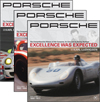|
Porsche: Excellence Was Expected
Price: TBD
|
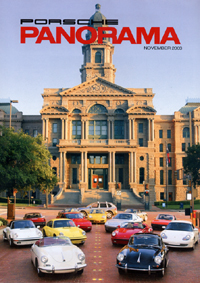
Panorama - November 2003
"Ferry Porsche was that remarkable man, a progressive conservative. He was careful, saw all the possible risks that could confront his company but at the same time he was prepared to do some new things. "
PANORAMA INTERVIEW
KARL LUDVIGSEN
Karl Ludvigsen"s Porsche: Excellence Was Expected became the essential reference work on Porsche the moment it was published in 1978. Ironically, Ludvigsen left an 11-year career as a freelance writer just before the book came out, joining Fiat Motors of North America as an executive vice president. In 1980 he moved to England as a vice president of Ford of Europe with responsibilities that included the launching of Ford"s Group C effort. In 1983 he left Ford to found Ludvigsen Associates, a consulting company, working with many of the world"s major car makers on a wide range of activities including marketing, forecasting of market potential, purchasing, and product definition. Recently he sold the consulting company and moved his personal library and home to Suffolk from London. Ludvigsen has brought his monumental Porsche history up to date in three volumes, some 1500 pages, just released by Bentley Publishers. Now as then, we wanted to know the story behind the story. In this interview, taped at Bentley"s headquarters in Cambridge, Massachusetts, Ludvigsen shares new insights into the Porsche world.
Betty Jo Turner: You"ve now added another 25 years of history to the story of the Porsche company. How daunting a challenge was that?
Ludvigsen: It"s as they say?you eat an elephant one bite at a time?and I guess that"s what I did. The same thing happened with the update as happened with the original book. The chapters underwent fission. As I would write a chapter, it would split into two because there was too much information for one. A defining moment was when the folks at Bentley told me we were going to be able to update the original text as well. They sent the book to India and had people there retype it in order to produce an electronic file. So it was daunting but wonderful to be able to review the original book and to fix some things and I hope not commit too many more errors. It allowed me to add a lot in terms of things that have been learned in the meantime.
BJT: Have there been any completely new insights?
Ludvigsen: One of the new things that I say in the book is that as far as I can tell, the so-called original Porsche, the first 356 roadster, was a Volkswagen. It was not a Porsche. It was done as a study for Volkswagen at a time when Porsche and its engineers were trying to get back on the track with VW It"s been commonly believed that this was always and forever the first Porsche, but the reference material that"s available on the car now suggests that it"s a Volkswagen prototype. It was something they proposed?any consulting engineer likes to have things up his sleeve and I think that they developed that project as something to present to Volkswagen as a suggestion of what they could do. They also had an old 60K10 coupe hanging around and when they started thinking about making cars, they thought well we"ve got these two cars, let"s call them Porsches. We can sort of say we have Porsches around instead of these prototypes. As a result, some people like to call the 60K10 the first Porsche, but of course it isn"t. It"s a car that was built as a Volkswagen racing car and later on, after the war, Porsche, I think very ingeniously, used these two cars, the roadster and the 60K10, to say we are in the car business. We"re going to put Porsche on the front of these cars. BJT: And the rest of the series from Gmünd? Ludvigsen: They are the first Porsches. The 356/02?the first Gmünd coupe?is the first Porsche, in my view The roadster was kind of retroactively called a Porsche in an opportunistic way. Why not? But I don"t think it was originally conceived as a Porsche production car, or even as a Porsche.
BJT: They were actually not a production car company at that time.
Ludvigsen: No, they were not. They were still at that stage in the business of selling their consulting services and they did get a good contract with VW. The first book also covers the period of the 908, the 917, the early high-spending period of Porsche racing. Only recently, when I read Ferdinand Piëch"s autobiography, did I realize that, as he states in the book, Volkswagen substantially funded this racing activity. They had an open-ended deal with Volkswagen that Volkswagen would pick up a substantial share of their racing budget as long as they raced air-cooled cars because this was a form of advertising for the Beetle, an air-cooled car which was increasingly a kind of anomaly in the water-cooled age.
BJT: So what we knew as Excellence Was Expected, has morphed considerably.
Ludvigsen: It has and there are a fair number of new illustrations in the original parts of the book as a well.
BJT: When the first book came out, you indicated that as you talked to people at Porsche it was sometimes difficult to get them to talk about their living history. Has that changed?
Ludvigsen: Then, as now, be cause the Porsche history is still quite a modern history and there are a lot of recent events here, there was a certain amount of attempting by various people to cover certain things up and make them seem nicer than they really were. That"s natural, I suppose, but Porsche has moved into a little bit more manipulative mode in its way of dealing with the outside world. A notable example is the absolute shutting down of the rumors that used to come out in Auto Motor und Sport. That magazine was always extremely well informed about what was coming from Porsche, and they"ve very effectively closed that off. They"ve clearly gone now to the relevant engineers and people involved and said don"t talk to anybody without our permission. I"m not saying that"s bad. Quite the contrary, if you"re running a business you like to be able to manage your contact with the media and Porsche has gone from an extremely leaky company to a very tight company. So the plumbers have been at work, to use a White House analogy. And that"s been effective. One of my reasons for wanting to go to some of the recent car launches was not so much to see the car, although that was of course very helpful, but to talk to the engineers. And on several occasions, I was told that I was asking questions that I shouldn"t be.
BJT: What kind of questions?
Ludvigsen: Questions about various aspects of the car, why they did certain things. So this was a sign of the new approach to things at Porsche. Nevertheless, I have to say that those occasions were extremely useful. I did get quite a bit of information, although perhaps more at the bar at the end of the day than at any formal discussion session. In talking to the engineers this time, especially the people that I knew from the past, I sometimes got the impression that it was a kind of catharsis for them to be able to talk to me because they really hadn"t been able to speak to anybody outside the company about some of the very difficult and challenging periods that they have been through over the last 25 years. Some of them seemed pleased to be able to talk quietly to somebody who understood their situation and was familiar with their life and work. And so that meant that this time I was able to get some very good insights.
When I did the first book, I was in America and I made really only one research visit to Porsche during which I rooted through every cupboard and desk that I could find. This time they were very helpful in arranging interviews for me with lots of people. I don"t think there was anybody I wanted to speak to that I couldn"t. I came back for second interviews with some people like engineers Peter Falk and Paul Hensler. I talked with Norbert Singer a couple of times because there was a whole new era of racing that I really didn"t know that much about from the inside. I feel that we"ve characterized that pretty well. I"m quite pleased with the ending of one of the chapters. I try to dedicate the end of the chapter to why they were so successful at Le Mans. What"s the secret of success at Le Mans? And Singer said, "Well, every year we go there and we learn some new things and the list gets longer every year." That"s a good way to put it.
BJT: Were there any constraints on you when you gathered that kind of material?
Ludvigsen: The only constraint was that when I copied material in the archives, I had to leave it behind and somebody had to decide whether I was allowed to have it or not. There were some occasions where research material that I really wanted wasn"t sent to me. You can only ask yourself why people behave like that when someone is trying to make a reasonable fist of describing in a unique and probably never to be repeated manner the history of their company. But they say a lot of things are sensitive and they feel maybe people shouldn"t know about this and so on. Fortunately I don"t think that"s greatly dented the general thrust of what I"ve been able to tell.
As I mention in the book, I was a very fortunate that Paul Hensler had retired but was kept on by Porsche to collate key information about their projects and put them into a kind of successor to the ten-year-books of earlier times. This was a godsend. I saw this material and I was allowed to copy what was relevant. A lot of it was copies of press reports and news releases-it wasn"t all profound internal documentation, but there was enough there to give me a fantastic leg up on getting to grips with the history, some of the things that had been done and why they had been done.
BJT: I confess that I haven"t read all 1574 pages of the new three-volume book, but in sampling chapters I ran across a phrase that grabbed me. You referred to "the pessimistic Bott." He was, of course, the great R&D chief, one of the giants of Porsche history. Tell me about the pessimistic Bott.
Ludvigsen: Helmuth Bott was a powerhouse engineer in his day at Porsche and he was the arch representative of the era in which the product decisions at Porsche were made at Weissach. They weren"t made at Ludwigsburg and Ludwigsburg chafed under this situation. The marketing people tried their best, as I mention in the book, to come forward and propose product plans and strategies, but they were essentially brushed off by Weissach. Weissach determined the way the cars would be built, what kind of specification they would have and Bott did that. I like the comment from Tony Lapine, who headed the style studio at the time. He said, "Nobody ever succeeded in overloading Bott." He also got a lot of credit from Ron Dennis at McLaren, who is, let"s face it, no pushover, for the things Bott was able to do for the Fl engine program. Even though the program was budgeted and paid for by TAG, Ron said, "I know Helmuth found some ways to get money into that program. I don"t know how, but I know he did it." He could present a program in a very sober, rational way that would gain the approval of the Supervisory Board.
But the reference you"re asking about was after he retired. Somebody was chatting with Bott and he said, "You know, I think maybe the future of Porsche is going to be as an engineering consulting company that builds cars only as a kind of shop window for its skills and abilities." He was that pessimistic at that time. This was not long after he left the job, when the economy was in the dumps and they were struggling to get some new product going.
There is no question that Bott left under a cloud with a big 959 on it. The fact that he was the driving force behind this program and that it was so financially unrewarding for Porsche was the problem. Even though you have to say that in any company of that nature the Supervisory Board had approved all of the decisions. You can"t say that he did it on his own?quite the contrary?but it was his car and indeed material shows that he drove the Group B project right from the beginning.
BJT: The production 911s that came along after that were the 964 series, the Carrera 2 and 4, and they met with some criticism.
Ludvigsen: They did and you can always go back and second-guess things, but those cars had some very positive characteristics. About the Carrera 4, people said that it drives like a German car, but it doesn"t drive like a Porsche. They had overemphasized traction instead of agility and agility becomes a very important feature of the 993, thanks to Peter Falk"s analysis that I describe in the book. And so there were some problems with the 964. The technology was there but it had kind of taken Porsche down a dead end street and in fact the atmosphere when Ulrich Bez arrived as head of R&D was that the 964 essentially had shown that the era of the 911 was over. Bez and his team faced the challenge of saying to management, no, we think we can make a better 911. Don"t give up on this car. It"s a great hero of the modern automobile world and we ought to be able to make a better one. And that"s what they set out to do with Horst Marchart handling the engineering details and Bez leading the effort. The 964 was a point where the Supervisory Board, the owners of the company, felt they had gone as far as they could go with the car. They were quite content to say stop already. And with the 993, a new interpretation that was very satisfactory was found.
BJT: And this period is at the core of the new volumes.
Ludvigsen: Yes, very much so, it"s very much part of the new volumes and then, of course, in parallel evolution there were the various turbo versions and how they came about.
BJT: Speaking of Turbos, what was the Type 965?
Ludvigsen: Well, the 965 you"d have to say was along Bott lines. It was to be a twin turbo four-wheel-drive, all singing, all dancing, top of the range turbo model. We have the story in the book. We have a couple of pictures of styling models of the car and they built a number of prototypes. Bez essentially killed the 965 program. He felt it would be way too expensive, too complex, too heavy, too everything and eventually, during his administration, the project was stopped. They regrouped and relaunched a very clever turbo adaptation that kept the Turbo in business. The 965 also served as a trial horse for some other engines that they were thinking of for the future, liquid cooled V8s in the rear, that sort of thing, which I think we show for the first time in the book.
BJT: You also show a photo in the book of a precursor of the Boxster that hasn"t been widely seen before.
Ludvigsen: I hope people will find a number of surprises in the book. I certainly found some surprises. Of course, nothing surprises me about Porsche really, but I was able to find some missing links, if you will, in certain areas, and again the aim is to show what really happened behind the scenes, how these cars came t be and what really happened.
BJT: Besides the picture of that early Boxster, can you think of other surprises?
Ludvigsen: Sure. We"ve got a picture of one of the cars in the range that Ferdinand Piëch was hoping t introduce in 1972. He had mapped out a complete range of modular engines for six and eight cylinders, horizontal, mid engined, water cooled, and this was his vision of the future of Porsche in the 1970s. It was the way he planned to go and at that time he was technical director of the company.
BJT: Were these sports cars?
Ludvigsen: Yes, this would have been a complete replacement of the existing Porsche range and he had made some steps toward beginning the tooling for some of these cars and so forth, but Peter Porsche, who was then in charge of production, was responsible t for saying they were not going to go this far, they were not going to change the whole range this comprehensively. Soon after that happened, in 1972 we had the o decision for Porsche and Piëch family members to step out of management positions in the company.
Certainly much of the book is dedicated to relating n the battles between the two families which one business magazine called "crash test of the clans." I have to say that was a good title. It"s part of what makes Porsche Porsche, the incredible battles between Piëchs and Porsches.
BJT: Do you see that tempered today or do you think it still has its effect on the company?
Ludvigsen: It has moderated thanks to the fact that the third generation, the sons of Louise Piëch and Ferry Porsche, are now getting a bit older and the next generation after that is more diffuse. For that reason and because of the fact that Wiedeking is such a strong manager at Porsche-nobody is going to come in and overrule him. Ferdinand Piëch said that he was possibly in the frame to come over and run Porsche at the time that Wiedeking was engaged and he was candid enough to say that he"s not sure he would have made as good a fist of it as Wiedeking has. So he"s praising a third party, not a Porsche. Those conflicts and stresses are still there, but are maybe less pronounced with the passage of time.
BJT: How important do you think it is for Porsche to get back on the track?
Ludvigsen: I don"t have any problem saying I think it"s pretty darn important for them to get back into racing. Quite soon they will be in the same situation that Mercedes Benz was in 1962 or "63 after they had stopped racing in 1955 in that they wouldn"t know how to do it. The people would be gone. There was already a big de-emphasis on the key racing group in the late 1980s and early 1990s and that hurt the program of supplying an engine to Arrows for Formula One, no question about it. The capabilities weren"t as great as they had been. They had a nice resurgence in the late 1990s with their GT1 racers but I would say in another year or two they"ll have to start from scratch. They"ve lost a lot of key people. That long list of things learned from Le Mans that Norbert Singer referred to will not be there anymore. And if it were, nobody would know what to do with it.
And yet, I"m convinced that a strong participation in some form of top line racing is a part of the Porsche DNA and to go too long without it would be tragic in terms of the image of the brand. Clearly with the Carrera GT, Wiedeking spelled out the motivation for its development very robustly. He was tired of seeing these other guys coming out with their killer sports cars and he determined to show them that Porsche can still make a very effective, major league, high performance road car. So he"s not an uncompetitive person, quite the contrary, but his feelings of competition don"t include motorsport. He was asked about Le Mans and he said it"s just a bunch of Volkswagens running around-and I see what he means. That"s his view. Le Mans type racing, at the very top, is clearly a Porsche style venue. We have a little bit to say in the final chapter about the Daytona Prototype program which I think is interesting but Porsche doesn"t like it very much because they"ve not allowed the cars to run as they"re legally supposed to with their headlight shapes displayed and the crest had to be taken off.
BJT: In the first pages on the Cayenne, you note that Ferry Porsche was not averse to cars that weren"t sport cars.
Ludvigsen: Absolutely. He felt in his time much as the management does today which is that it"s risky to put all your eggs in one basket. Ferry Porsche was that remarkable man, a progressive conservative. He was careful, saw all the possible risks that could confront his company but at the same time he was prepared to do some new things. People I talked to who worked with Ferry said there is no question that he was Porsche"s model customer. "The fact that Ferry was there meant that we didn"t have to do any market research, we didn"t have to study anything, we just had to find out if Ferry liked it." His tastes and desires, the things that he thought were good, guided what Porsche did in a very significant way. That applied, for example, to the four-door 928. There were a couple of those studies done, one as a birthday car. He looked at one of the prototypes and said, "Well, I know I wanted it, but it"s not right. Now that I see it, it"s not right for us." So he was perfectly prepared to own up to that. A car that he viciously disliked was the Panamericana concept car. This was one of the famous Ferry Porsche birthday cars and he was photographed standing next to the Panamericana, but he really hated it.
BJT: How would you summarize your goal for Excellence Was Expected this time around?
Ludvigsen: In writing the new book, I had certain standards to meet. The standard of the original book, in my mind, was guided by the fact that each person reading it would be a Porsche expert on his car and he would turn immediately to the chapter about his car, read that and see if it bore any relation to what he knew or thought about his Porsche. So that set the standard for what I had to achieve with this extension of the book. In addition, the Bentley people have done a great job of making this book more accessible than the first. With the complete index included in each volume and better contents pages and subheads, we"ve tried to make it easier to find what you"re looking for in the book.
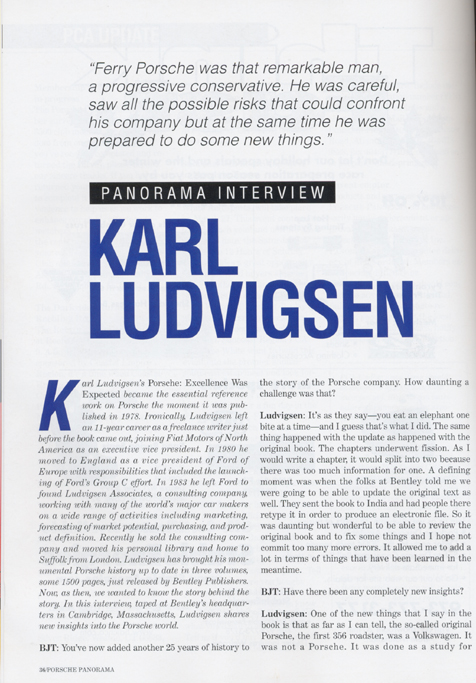
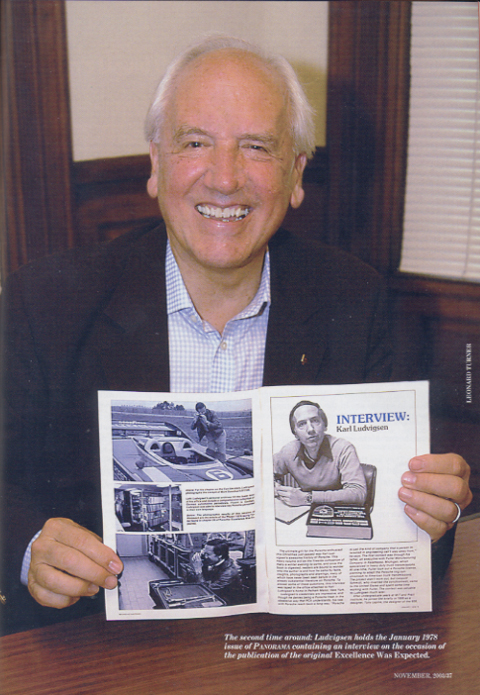
The second time around: Ludvigsen holds the January 1978 issue of Panorama containing an interview on the occasion of the publication of the original Excellence Was Expected.
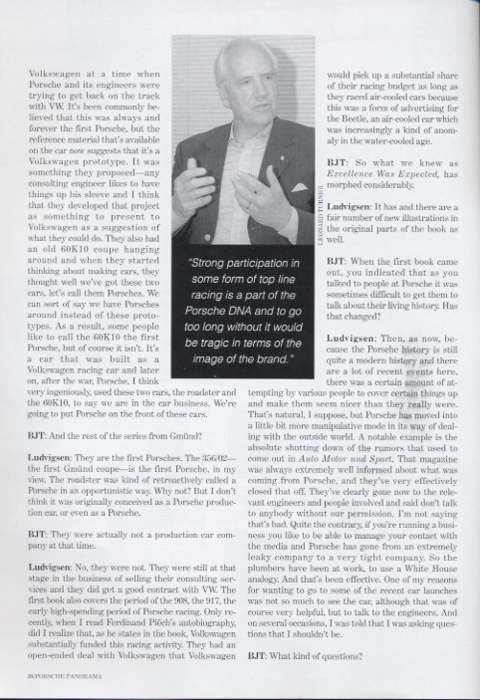
"Strong participation in some form of top line racing is a part of the Porsche DNA and to go too long without it would be tragic in terms of the image of the brand."
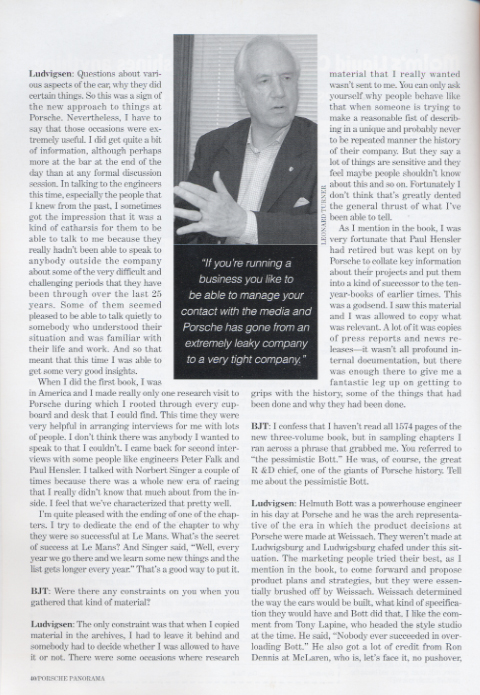
If you"re running a business you like to be able to manage your contact with the media and Porsche has gone from an extremely leaky company to a very tight company."
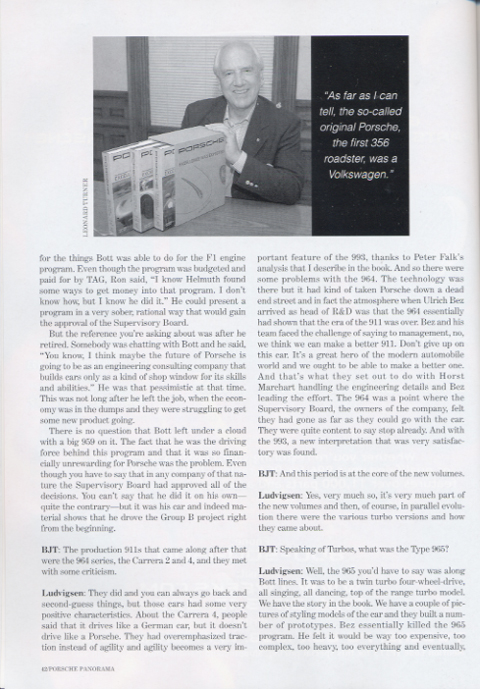
As far as I can tell, the so-called original Porsche, the first 356 roadster, was a Volkswagen.
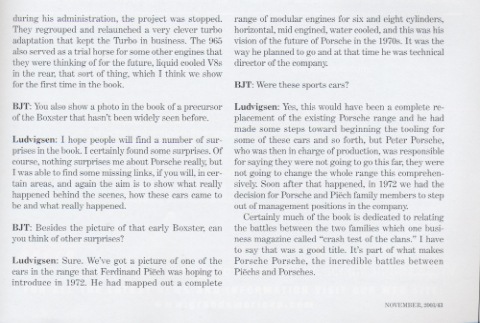
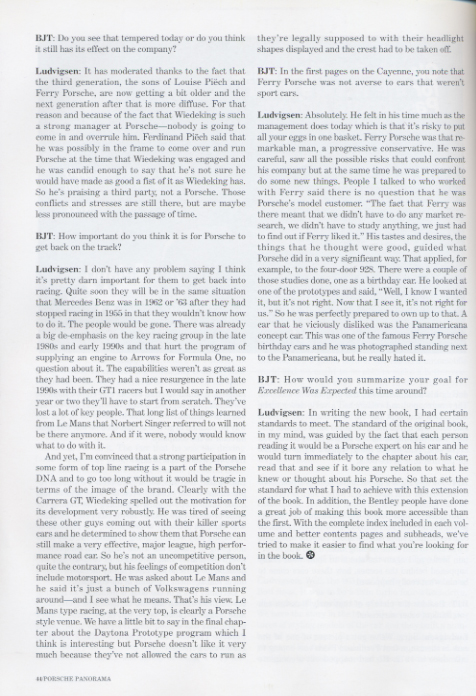
![[B] Bentley Publishers](http://assets1.bentleypublishers.com/images/bentley-logos/bp-banner-234x60-bookblue.jpg)
